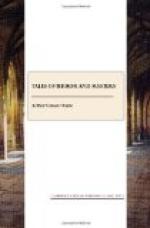I had known Dacre in England, for my researches in the Assyrian Room of the British Museum had been conducted at the time when he was endeavouring to establish a mystic and esoteric meaning in the Babylonian tablets, and this community of interests had brought us together. Chance remarks had led to daily conversation, and that to something verging upon friendship. I had promised him that on my next visit to Paris I would call upon him. At the time when I was able to fulfil my compact I was living in a cottage at Fontainebleau, and as the evening trains were inconvenient, he asked me to spend the night in his house.
“I have only that one spare couch,” said he, pointing to a broad sofa in his large salon; “I hope that you will manage to be comfortable there.”
It was a singular bedroom, with its high walls of brown volumes, but there could be no more agreeable furniture to a bookworm like myself, and there is no scent so pleasant to my nostrils as that faint, subtle reek which comes from an ancient book. I assured him that I could desire no more charming chamber, and no more congenial surroundings.
“If the fittings are neither convenient nor conventional, they are at least costly,” said he, looking round at his shelves. “I have expended nearly a quarter of a million of money upon these objects which surround you. Books, weapons, gems, carvings, tapestries, images—there is hardly a thing here which has not its history, and it is generally one worth telling.”
He was seated as he spoke at one side of the open fire-place, and I at the other. His reading-table was on his right, and the strong lamp above it ringed it with a very vivid circle of golden light. A half-rolled palimpsest lay in the centre, and around it were many quaint articles of bric-a-brac. One of these was a large funnel, such as is used for filling wine casks. It appeared to be made of black wood, and to be rimmed with discoloured brass.
“That is a curious thing,” I remarked. “What is the history of that?”
“Ah!” said he, “it is the very question which I have had occasion to ask myself. I would give a good deal to know. Take it in your hands and examine it.”
I did so, and found that what I had imagined to be wood was in reality leather, though age had dried it into an extreme hardness. It was a large funnel, and might hold a quart when full. The brass rim encircled the wide end, but the narrow was also tipped with metal.
“What do you make of it?” asked Dacre.
“I should imagine that it belonged to some vintner or maltster in the Middle Ages,” said I. “I have seen in England leathern drinking flagons of the seventeenth century—’black jacks’ as they were called—which were of the same colour and hardness as this filler.”
“I dare say the date would be about the same,” said Dacre, “and, no doubt, also, it was used for filling a vessel with liquid. If my suspicions are correct, however, it was a queer vintner who used it, and a very singular cask which was filled. Do you observe nothing strange at the spout end of the funnel.”




